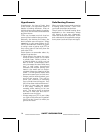
SAFETY EQUIPMENT
PFD Types
There are five types of approved PFDs.
PFD Type I, Wearable has the greatest
required buoyan cy. Its design allows
for turning most unconscious persons
inthewaterfromfacedownpositionto
a vertical or slightly backward, face-up
position. It can greatly increase the
chances of survival. Type I is most
effective for all wate rs, especially off-
shore when rescue may be delaye d. It
is a lso the most effective in rough wa-
ters
F00A2CY
TYPE I — WEARABLE
PFD Type II, Wearable turns its wearer
in the same way as Type I, but not as
effectively. The Typ e Il does not turn as
many persons under the same condi-
tions as a Type I. You may prefer to use
this PFD where there is a probability of
quick rescue such as in areas where
other people are commonly involved in
water activities.
F00A2DY
TYP E II — WEA RABLE
PFD Type III, Wearable allows wear-
ers to place themselves in a vertical
or slightly backward position. It does
not turn the wearer. It maintains the
wearer in a vertical or slightly back-
ward positio n and ha s no te ndenc y
to turn the wearer face down. I t has
the same buoyancy as a Type Il PFD
and may be appropriate i n areas where
other people are commonly involved in
water activities.
F00A2EY
TYPE III — WEARABLE
PFD Type IV, Throwable is required
in addition to the PFDs previously dis-
cussed. The most common Type IV
PFD is a buoyant cushion or ring buoy.
It is designed to be thrown to a per-
son in t he water, grasped and held by
the user until he or she is rescued. A
Type IV PFD s hould alwa ys be in ser-
viceable condition and immediately
available for use. Grasping this P FD
may be difficult if the rescue is de layed
or if the user is overcome by hypother-
mia (loss of body heat).
F00A2FY
TYPE IV — THROWABLE
16
_______
SAFETY INFORMATION
________


















